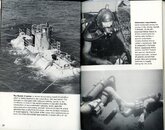- Messages
- 5,141
- Reaction score
- 4,137
- # of dives
- 5000 - ∞
It is indeed a Samson..."The standard of the world"
Herb Samson was located on 17th street in Coast a Mesa, California (Which was known as Goat Hill until 1960.) . In addition to his very fine camera systems he designed and marketed the very radical Samson world record spear gun and a very powerful 38 caliber power head. At one time more world records were set with a Samson Spear gun than any other spear gun on the market. Herb was also an avid spear fisherman and set the very first BSB (AKA GSB) record.
The housing pictured was a Samson Professional which accepted a 16 MM B&H with a 400 foot reel, or a 35MM B&H with a 400 foot reel. (The great UW photographer Bill Mc Donald purchased the last one Herb produced and used a 16 mm B&H with a 400 foot roll ) This particular model was equipped with a folding sports finder on the top and a optical view finder in the housing
Herb made two models of this camera the smaller 16 mm Sportsman with a 16 MM B&H which was 35 pounds as opposed to the larger Professional which had a weight of 90 pounds.
The 16 MM Sportsman could be equipped with a spear gun mount which could also be converted in to a single or triple power head mount, as well as a through the housing viewfinder. Only two housings with very expensive spear gun mounts are known to have survived the passage of time.
Previous discussions about this wonderful camera and the man behind the camera can be found on this board as follows
Samson Camera housing [Archive] - ScubaBoard - Scuba Diving Forum - Diving Social Network
'Also at the Portage Quarry "Legends of diving" site as follows:
~~ Orange County - Did You Know? - by Dr. Sam Miller - History of SCUBA Diving ~~
~~~~~~~~~~~~~~~~~~~~~~~~~~~~~~~~~~~~~~~~~~~~~~~~
Yes I knew Herb Samson very well, we were in the same spearfishing club occasionally dove together. Often after a dive at Laguna Beach I (we) would stop by his shop for a visit.. He certainly enjoyed diving and talking diving
One of my first purchases after service in the Korean war was a Samson camera housing with a B&H camera and a Elgeet 12 MM WA lens, made several forgettable movies then retired the Samson to my den, where it still resides in a place of honor.
At almost a $1000.00 1958 dollars it was many many steps up from the current "go pro." There is just no comparison !
Now we know more than needed about the cameras it is appropriate to return to "The man in the sea program."
Herb Samson was located on 17th street in Coast a Mesa, California (Which was known as Goat Hill until 1960.) . In addition to his very fine camera systems he designed and marketed the very radical Samson world record spear gun and a very powerful 38 caliber power head. At one time more world records were set with a Samson Spear gun than any other spear gun on the market. Herb was also an avid spear fisherman and set the very first BSB (AKA GSB) record.
The housing pictured was a Samson Professional which accepted a 16 MM B&H with a 400 foot reel, or a 35MM B&H with a 400 foot reel. (The great UW photographer Bill Mc Donald purchased the last one Herb produced and used a 16 mm B&H with a 400 foot roll ) This particular model was equipped with a folding sports finder on the top and a optical view finder in the housing
Herb made two models of this camera the smaller 16 mm Sportsman with a 16 MM B&H which was 35 pounds as opposed to the larger Professional which had a weight of 90 pounds.
The 16 MM Sportsman could be equipped with a spear gun mount which could also be converted in to a single or triple power head mount, as well as a through the housing viewfinder. Only two housings with very expensive spear gun mounts are known to have survived the passage of time.
Previous discussions about this wonderful camera and the man behind the camera can be found on this board as follows
Samson Camera housing [Archive] - ScubaBoard - Scuba Diving Forum - Diving Social Network
'Also at the Portage Quarry "Legends of diving" site as follows:
~~ Orange County - Did You Know? - by Dr. Sam Miller - History of SCUBA Diving ~~
~~~~~~~~~~~~~~~~~~~~~~~~~~~~~~~~~~~~~~~~~~~~~~~~
Yes I knew Herb Samson very well, we were in the same spearfishing club occasionally dove together. Often after a dive at Laguna Beach I (we) would stop by his shop for a visit.. He certainly enjoyed diving and talking diving
One of my first purchases after service in the Korean war was a Samson camera housing with a B&H camera and a Elgeet 12 MM WA lens, made several forgettable movies then retired the Samson to my den, where it still resides in a place of honor.
At almost a $1000.00 1958 dollars it was many many steps up from the current "go pro." There is just no comparison !
Now we know more than needed about the cameras it is appropriate to return to "The man in the sea program."
Last edited:





